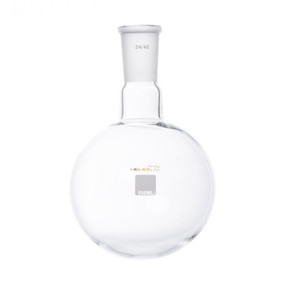
Helios
Short Path - Receiving Flask 250ml 24/40
Receiving flask is a specialized piece of laboratory glassware commonly used in distillation processes, particularly in short path distillation setups. Here are its key characteristics:
Description:
-
Material: made of borosilicate glass, which is resistant to thermal shock and chemical corrosion.
-
Volume: A 250 mL capacity indicates it can hold up to one liter of liquid, making it suitable for receiving distillates or condensates.
-
Design:
- Shape: The flask has a round bottom design, allowing for even heating and stabilization.
- Neck: It comes with a neck size 24/40 that is often connected to a distillation apparatus or a condenser.
-
Functionality:
- Used in conjunction with a short path distillation apparatus, it collects distilled liquids that have been separated from impurities based on their boiling points.
-
Applications: Commonly utilized in the extraction of essential oils, purification of liquids, and in chemical synthesis where high purity of the final product is required.
Usage:
- Simply connect the flask to the distillation assembly, ensuring a tight seal to prevent vapor loss.
- As the distillation process occurs, the desired components will condense and flow into the receiving flask.
Maintenance:
- After use, it should be carefully cleaned and inspected for any cracks or defects to ensure it remains usable and safe for future experiments.
This equipment is essential for chemists and researchers focused on purification techniques in laboratory settings.

Short Path - Receiving Flask 250ml 24/40
Receiving flask is a specialized piece of laboratory glassware commonly used in distillation processes, particularly in short path distillation setups. Here are its key characteristics:
Description:
-
Material: made of borosilicate glass, which is resistant to thermal shock and chemical corrosion.
-
Volume: A 250 mL capacity indicates it can hold up to one liter of liquid, making it suitable for receiving distillates or condensates.
-
Design:
- Shape: The flask has a round bottom design, allowing for even heating and stabilization.
- Neck: It comes with a neck size 24/40 that is often connected to a distillation apparatus or a condenser.
-
Functionality:
- Used in conjunction with a short path distillation apparatus, it collects distilled liquids that have been separated from impurities based on their boiling points.
-
Applications: Commonly utilized in the extraction of essential oils, purification of liquids, and in chemical synthesis where high purity of the final product is required.
Usage:
- Simply connect the flask to the distillation assembly, ensuring a tight seal to prevent vapor loss.
- As the distillation process occurs, the desired components will condense and flow into the receiving flask.
Maintenance:
- After use, it should be carefully cleaned and inspected for any cracks or defects to ensure it remains usable and safe for future experiments.
This equipment is essential for chemists and researchers focused on purification techniques in laboratory settings.







